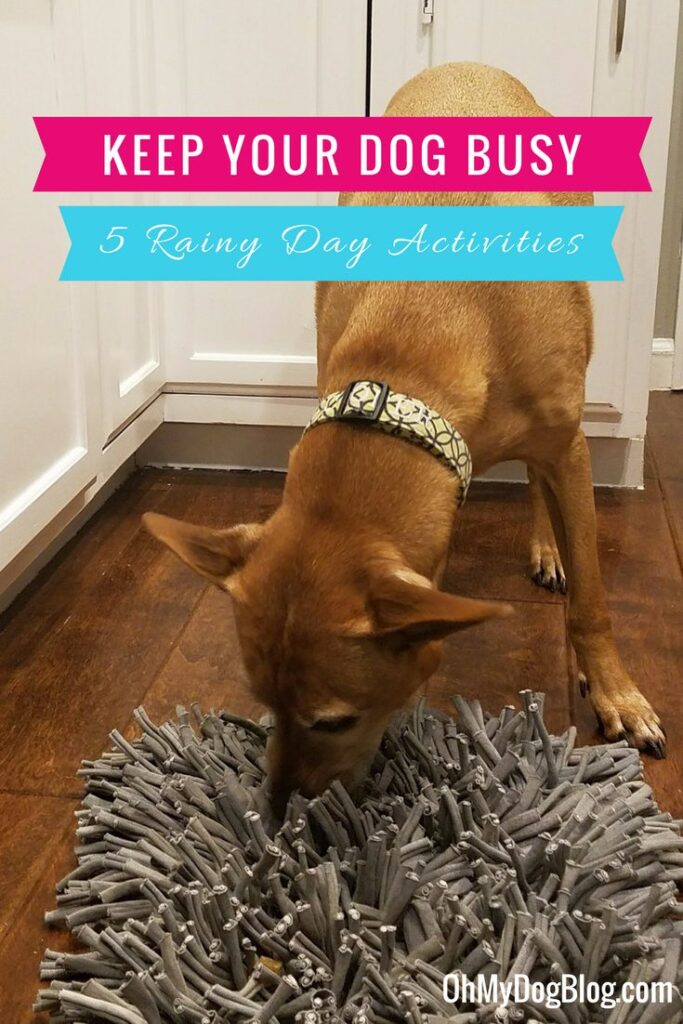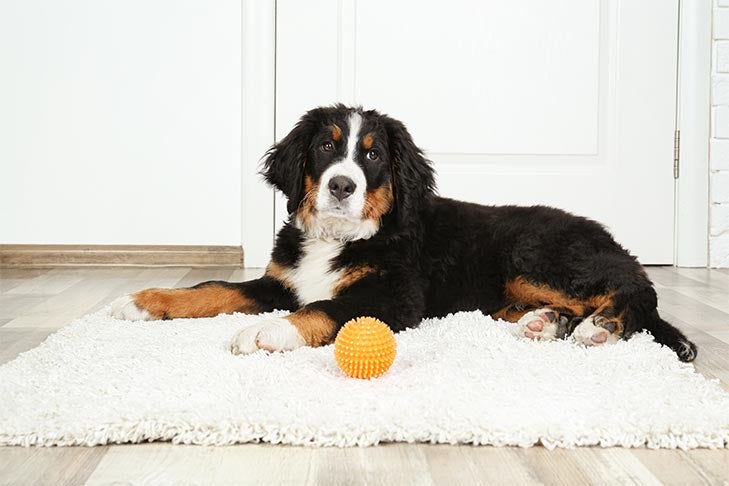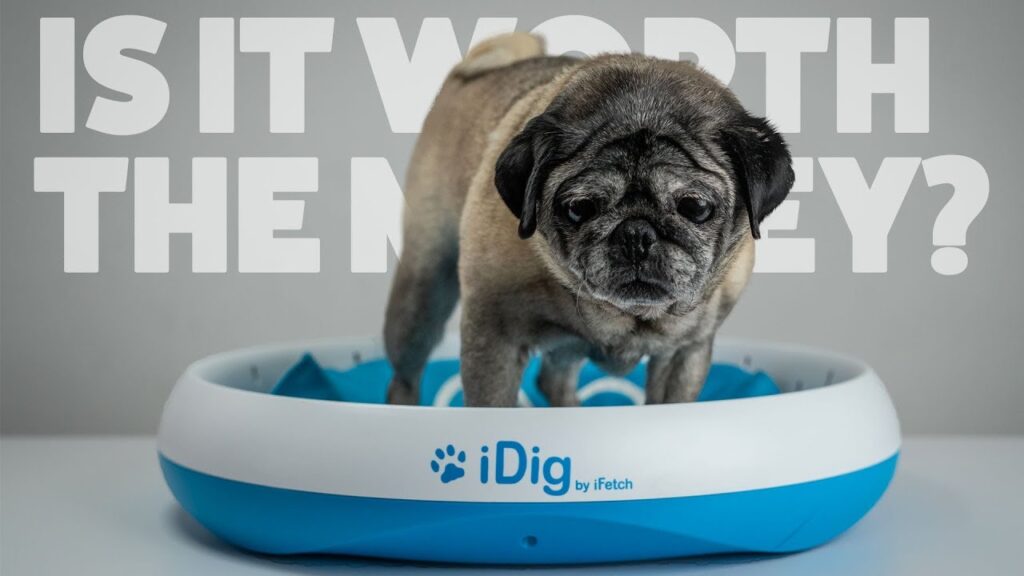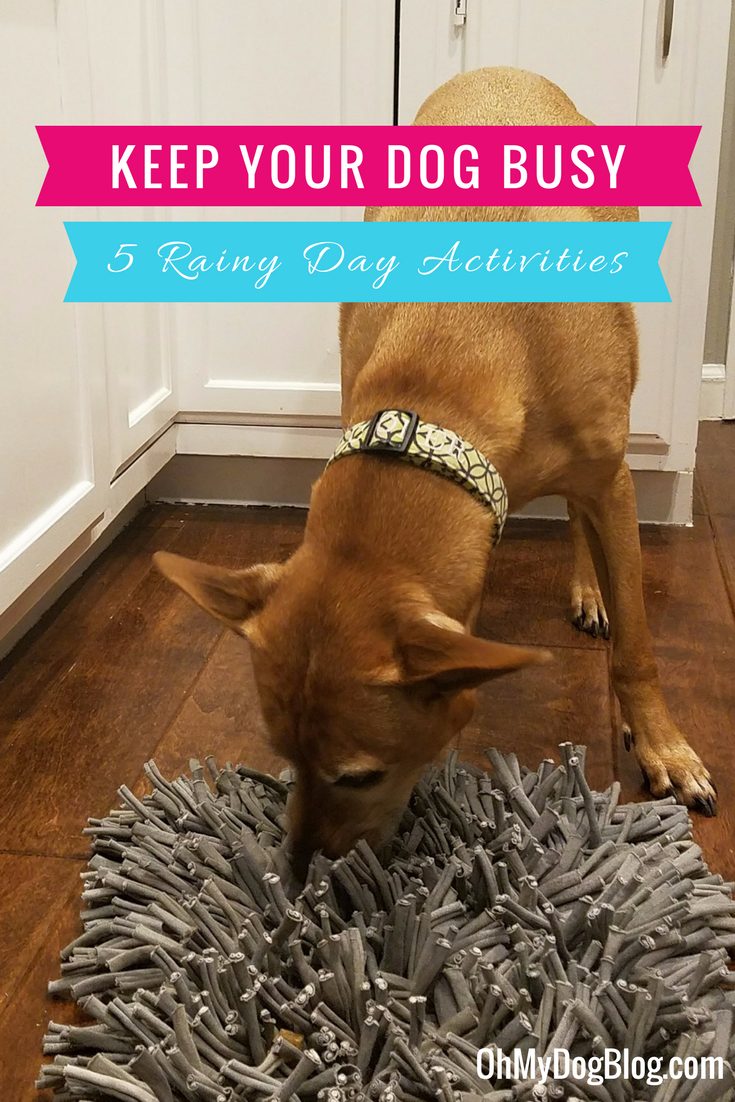When bad weather strikes and your furry friend can’t go outside to play, it’s important to have a dog-friendly indoor play space ready to keep them entertained and active. In this article, we’ll explore some simple yet effective ways to create an enjoyable space for your canine companion, filled with fun toys, interactive games, and cozy spots for them to relax. With these tips, you’ll never have to worry about your dog feeling bored or restless during those rainy or snowy days.
Choosing the Right Space
Determining the Size of the Play Space
When creating a dog-friendly indoor play space, it’s essential to consider the size of the area. The size will depend on the breed, size, and energy levels of your dog. If you have a small dog, a room or a designated corner of a room may be sufficient. However, if you have a large, energetic dog, you may need a larger space to accommodate their play and exercise needs. Remember, the more space they have, the better they can move around and play freely.
Considering the Flooring
The flooring of your dog’s indoor play space is crucial for their safety and comfort. Opt for a flooring material that is easy to clean and doesn’t pose any risks to your dog’s paw pads. Avoid materials like carpeting, which can be difficult to clean and may harbor allergens or odors. Instead, consider using vinyl or rubberized flooring, as these can provide traction and are easy to wipe clean. If you’re concerned about your dog slipping on a smooth surface, you can also opt for interlocking foam mats, which provide both comfort and stability.
Removing Hazards
To create a safe indoor play space, it’s important to remove any hazards that could potentially harm your dog. Take a thorough look at the area and remove any small objects, electrical cords, or toxic plants that your dog may chew on or ingest. Keep the space free from any sharp objects or furniture that could cause injuries during play. Remember to secure any loose electrical cords or wires to prevent your dog from tripping on them or chewing on them. By removing hazards, you can significantly reduce the risk of accidents and keep your dog safe during playtime.
Providing Adequate Exercise and Entertainment
Incorporating Toys and Interactive Games
To keep your dog entertained and mentally stimulated in their indoor play space, incorporate a variety of toys and interactive games. Consider toys that encourage problem-solving, such as puzzle toys or treat dispensers, which can keep your dog occupied and mentally engaged. Interactive games like hide-and-seek or tug-of-war can also provide physical exercise and bonding opportunities between you and your dog. Rotate the toys and games regularly to keep things fresh and exciting for your furry friend.
Setting Up Agility Equipment
If you have space and a high-energy dog, consider setting up some agility equipment to provide both mental and physical stimulation. Agility equipment such as tunnels, jumps, and weave poles can be easily purchased or even DIYed with household items. Engaging your dog in agility exercises can help improve their coordination, strength, and obedience skills. Remember to introduce the equipment gradually and always supervise your dog during agility sessions to ensure their safety.
Using Puzzle Feeders and Treat Dispensers
Puzzle feeders and treat dispensers are excellent tools to keep your dog entertained and mentally stimulated. These devices encourage your dog to work for their food, which helps prevent boredom and provides mental exercise. Fill them with your dog’s favorite treats or kibble, and watch as they try to figure out how to retrieve the rewards. Puzzle feeders and treat dispensers are not only fun for your dog but also can help slow down their eating and promote healthy digestion.
Designating Play Zones
To establish boundaries in your dog’s indoor play space, consider designating specific play zones. This can be done using baby gates or playpens, which can help ensure your dog’s safety and prevent them from accessing areas that are off-limits. Designate separate areas for various activities such as play, rest, and feeding. This helps create structure and allows your dog to differentiate between different areas of their indoor play space. By establishing play zones, you can better manage your dog’s activities and create a well-organized and welcoming space for them.

Creating a Safe Environment
Securing Electrical Cords and Wires
One of the most important aspects of creating a dog-friendly indoor play space is ensuring the safety of electrical cords and wires. Dogs, especially puppies or those with a strong chewing instinct, may be tempted to chew on cords, leading to electric shock or other injuries. Secure cords and wires to the wall using cable clips or conceal them behind furniture or rugs. Additionally, consider using cord protectors, which are plastic covers that can effectively deter dogs from chewing. By securing electrical cords and wires, you can prevent potential accidents and keep your dog safe from harm.
Limiting Access to Dangerous Objects
When creating a dog-friendly indoor play space, it’s essential to remove or secure any dangerous objects that could pose a threat to your dog’s well-being. Household items such as cleaning supplies, medications, sharp objects, and toxic plants should be stored away in locked cabinets or placed out of your dog’s reach. Pay attention to any potential hazards like open windows or balcony access and ensure they are properly secured. By limiting access to dangerous objects, you can create a safe environment where your dog can play and explore without any risks.
Ensuring Proper Ventilation
Proper ventilation is crucial for your dog’s comfort and overall health in their indoor play space. Ensure there is adequate airflow by opening windows or using fans to circulate fresh air. Stuffy or poorly ventilated spaces can lead to discomfort, respiratory issues, or even heatstroke. During extreme weather conditions, such as hot summer days or cold winter nights, consider using air conditioning or heating systems to maintain a comfortable temperature. Remember to monitor your dog’s behavior and adjust the ventilation accordingly to ensure their well-being.
Monitoring Temperature and Humidity
Maintaining a suitable temperature and humidity level in your dog’s indoor play space is important for their comfort and health. Dogs are sensitive to extreme temperatures, so it’s crucial to keep the environment within a safe range. Avoid exposing your dog to high temperatures or drafts, as they can lead to heat exhaustion or cold-related ailments. Use a thermostat or a monitoring device to keep track of the temperature and humidity levels, ensuring they are within a comfortable range for your dog. By prioritizing temperature and humidity control, you can create a safe and enjoyable space for your furry friend.
Establishing Comfort and Relaxation Areas
Providing Comfortable Bedding
Creating comfortable bedding areas within your dog’s indoor play space is essential for their relaxation and rest. Choose bedding materials that are soft, supportive, and easy to clean. Orthopedic memory foam beds are a great option for older dogs or those with joint issues, as they provide excellent comfort and support. Alternatively, you can use washable blankets or mats. Place the bedding in a quiet and cozy corner, away from any drafts or direct sunlight. By providing comfortable bedding, you can ensure your dog has a cozy spot to recharge and relax.
Including Cozy Hideouts
Dogs often appreciate having a private space where they can retreat and feel safe. Including cozy hideouts, such as dog tents or enclosed crates, can give your dog a sense of security and provide them with their own personal sanctuary within their indoor play space. Line the hideouts with soft bedding or blankets to make them even more inviting. By having a cozy hideout, your dog will have a peaceful retreat where they can unwind and recharge away from the hustle and bustle of the household.
Setting up a Relaxation Zone
In addition to play areas, it’s important to dedicate a relaxation zone within your dog’s indoor play space. This can be a separate area with comfortable bedding, calming music or white noise, and soft lighting. A relaxation zone allows your dog to unwind and destress after an energetic play session. Consider placing interactive toys or puzzle feeders in this area to provide mental stimulation while encouraging relaxation. By creating a designated relaxation zone, you can help your dog find balance and create a calming environment within their play space.

Maintaining Cleanliness
Using Easy-to-Clean Flooring
Keeping your dog’s indoor play space clean is crucial for their health and hygiene. Opt for flooring materials that are easy to clean and resistant to stains and odors. Vinyl, laminate, or tile flooring are excellent choices as they can be easily wiped or mopped clean. Avoid carpeting, as they can trap dirt, allergens, and odors. If necessary, place absorbent dog mats or rugs in high-traffic areas to prevent dirt and moisture from spreading. Regularly vacuum or sweep the play space to remove any fur, debris, or crumbs.
Establishing Regular Cleaning Routines
To maintain a clean and odor-free indoor play space, establish regular cleaning routines. Set aside dedicated time each week to thoroughly clean the space, including wiping down surfaces, vacuuming or mopping the floor, and washing any bedding or toys that require cleaning. Pay attention to areas where your dog spends the most time, such as their bedding or favorite play spots, as these tend to accumulate more dirt and odors. By establishing regular cleaning routines, you can ensure a clean and fresh environment for your dog to enjoy.
Selecting Dog-Friendly Cleaning Products
When cleaning your dog’s indoor play space, it’s important to use safe and dog-friendly cleaning products. Avoid using harsh chemicals or toxic substances that may cause harm to your dog if ingested or inhaled. Instead, opt for natural, pet-friendly cleaning solutions, such as vinegar or baking soda diluted in water, which are effective at removing stains and neutralizing odors. Always read the labels of cleaning products to ensure they are safe for use around pets. By using dog-friendly cleaning products, you can maintain a clean and safe environment for your furry friend.
Encouraging Socialization
Inviting Other Dogs for Playdates
Socialization is essential for a well-rounded dog, and bad weather doesn’t have to put a damper on your dog’s social life. Invite friends or family who have dogs for playdates in your dog’s indoor play space. Ensure that the visiting dogs are well-behaved and compatible with your dog’s temperament to prevent any conflicts. Supervise the playdates and provide plenty of toys and interactive games to keep all the dogs engaged and entertained. Socializing with other dogs not only provides physical exercise but also helps your dog develop important social skills and bonds.
Organizing Doggy Daycare or Indoor Dog Park Visits
If you don’t have access to other dogs for playdates, consider organizing visits to a doggy daycare or indoor dog park. These facilities provide a safe and controlled environment where your dog can socialize and interact with other dogs, even on bad weather days. Doggy daycares often have play areas designed specifically for dog interaction, offering an opportunity for your dog to burn off energy and engage in group play. Indoor dog parks are another great option, as they allow your dog to socialize and exercise while staying protected from the elements.
Arranging Playtime with Familiar Dogs
If your dog has close canine friends or family members with dogs, arrange playtime with them in your dog’s indoor play space. Familiar dogs can provide a sense of comfort and familiarity for your dog, making playtime more enjoyable and stress-free. Coordinate with the other dog owners to find a time that works for everyone and ensure that the play space is suitable for multiple dogs. By arranging playtime with familiar dogs, you can provide your dog with socialization opportunities and strengthen their bonds with their canine companions.

Ensuring Safety and Supervision
Applying Pet-Safe Cleaning Products
To maintain a clean play space while ensuring your dog’s safety, it’s important to use pet-safe cleaning products. Many conventional cleaning products contain chemicals that are toxic to pets if ingested or inhaled. Look for cleaning products that are specifically formulated for use around pets or opt for natural alternatives. Always check the labels for any warnings or precautions, and keep cleaning products out of your dog’s reach. By using pet-safe cleaning products, you can effectively clean your dog’s indoor play space without compromising their well-being.
Creating a Checklist for Safety Measures
Creating a checklist for safety measures can help ensure that your dog’s indoor play space is secure and free from potential hazards. Include items such as securing electrical cords, removing toxic plants, and limiting access to off-limits areas. Regularly review and update the checklist to account for any changes, such as new hazards that may arise or modifications to the play space. By having a checklist, you can systematically address safety concerns and create a safe environment for your furry friend.
Using Baby Gates or Playpens
Baby gates or playpens are valuable tools for ensuring your dog’s safety and managing their access within their indoor play space. Use baby gates to block off areas that are off-limits or contain potential hazards. Playpens can provide a safe and enclosed area where your dog can play freely without the risk of running into dangerous objects or areas. Choose sturdy and adjustable gates or playpens, ensuring they are securely fastened to prevent your dog from knocking them over. By using baby gates or playpens, you can create a secure and controlled environment for your dog’s indoor playtime.
Supervising Playtime
Supervision is essential during your dog’s indoor playtime to ensure their safety and prevent any potential accidents. Monitor your dog closely while they play, paying attention to any signs of discomfort, exhaustion, or aggressive behavior. Intervene if play becomes too rough or if one dog shows signs of stress or aggression towards another. Be an active participant in playtime, engaging in interactive games and providing guidance and support to your dog. By actively supervising playtime, you can prevent injuries and create a positive and safe environment for your furry friend.
Implementing Training and Mental Stimulation
Engaging in Obedience Training
Indoor playtime provides an excellent opportunity to engage in obedience training with your dog. Incorporate training sessions into their play routine to reinforce commands and improve obedience. Basic commands such as “sit,” “stay,” and “come” can be practiced indoors, as well as more advanced commands like “leave it” or “heel.” Use positive reinforcement techniques such as treats or praise to reward your dog for successfully following the commands. Obedience training not only provides mental stimulation but also strengthens the bond between you and your dog.
Teaching New Tricks and Commands
Bad weather days are perfect for teaching your dog new tricks and commands. Whether it’s a simple trick like “roll over” or a more complex command like “fetch the newspaper,” teaching your dog new skills can be both mentally stimulating and fun for both of you. Break down the tricks or commands into smaller steps, use positive reinforcement, and be patient with your dog as they learn. If you’re unsure about how to train certain tricks, consider consulting online resources or signing up for virtual dog training classes. Teaching new tricks and commands not only provides mental exercise but also boosts your dog’s confidence and promotes a positive learning experience.
Providing Interactive Dog Puzzles and Games
Another way to provide mental stimulation for your dog during indoor playtime is by using interactive dog puzzles and games. These toys are designed to challenge your dog’s problem-solving abilities and keep them engaged for extended periods. Treat-dispensing toys or puzzle feeders that require your dog to figure out how to access the treats can be mentally stimulating. Hide-and-seek games, where you hide treats or toys for your dog to find, also provide mental exercise while encouraging their natural instincts. Incorporate these interactive toys and games into your dog’s play routine to provide both mental and physical stimulation.

Promoting Physical Exercise
Using Treadmills or Doggy Exercise Wheels
When the weather outside is unpleasant, treadmills or doggy exercise wheels can be a great alternative to outdoor exercise. These devices allow your dog to get their daily dose of physical exercise, even indoors. Start by gradually introducing your dog to the treadmill or exercise wheel, using positive reinforcement and treats to create a positive association. Once your dog is comfortable, slowly increase the intensity and duration of their exercise sessions. Always supervise your dog when using these devices to ensure their safety and well-being.
Arranging Indoor Fetch Sessions
Fetch is a classic game that provides both mental and physical exercise for dogs. Although typically played outdoors, indoor fetch sessions can be just as fun and beneficial for your dog. Choose a suitable area within their play space where you can safely throw a soft toy or ball for them to retrieve. Ensure there is enough space for them to run without the risk of running into furniture or objects. Engage in interactive play with your dog, encouraging them to bring the toy back to you. Indoor fetch sessions can help burn off excess energy and keep your dog mentally stimulated.
Creating Obstacle Courses
To add excitement and physical exercise to your dog’s indoor play space, consider creating an obstacle course. Use everyday household items such as cushions, boxes, or hula hoops to set up a course that your dog can navigate through. Start with simple obstacles and gradually increase the difficulty level as your dog becomes more skilled. Incorporate tunnels, jumps, or weave poles to challenge your dog’s agility and coordination. Always ensure that the obstacles are safe and sturdy, and supervise your dog closely to prevent any accidents. By creating an obstacle course, you can provide fun and stimulating physical exercise for your furry friend.
Seeking Professional Help
Consulting with a Veterinary Behaviorist or Trainer
If you’re struggling to create a dog-friendly indoor play space or encountering behavioral challenges with your dog, it may be beneficial to consult with a veterinary behaviorist or a professional dog trainer. These experts can provide guidance tailored to your dog’s specific needs and help address any underlying behavior issues. They can also offer suggestions on how to create an engaging and safe indoor play space that meets your dog’s exercise and mental stimulation needs. Seeking professional help ensures that you provide the best possible care for your dog’s overall well-being.
Attending Indoor Training Classes or Workshops
Indoor training classes or workshops are excellent options for providing structured exercise and mental stimulation for your dog. These classes are specifically designed to be conducted indoors, allowing your dog to interact and learn in a controlled environment. Look for classes that focus on obedience training, agility exercises, or mentally stimulating activities. Not only do these classes provide valuable training opportunities for your dog, but they also offer socialization opportunities with other dogs and owners. Attending indoor training classes or workshops can be a fun and rewarding experience for both you and your furry friend.
Creating a dog-friendly indoor play space for bad weather days is essential to meet your dog’s exercise, mental stimulation, and socialization needs. By considering the size of the play space, providing adequate exercise and entertainment, creating a safe environment, establishing comfort and relaxation areas, maintaining cleanliness, encouraging socialization, ensuring safety and supervision, implementing training and mental stimulation, promoting physical exercise, and seeking professional help when needed, you can create an indoor play space that is both enjoyable and safe for your furry friend. So the next time bad weather strikes, you’ll be prepared with an engaging and inviting indoor play space for your dog.





